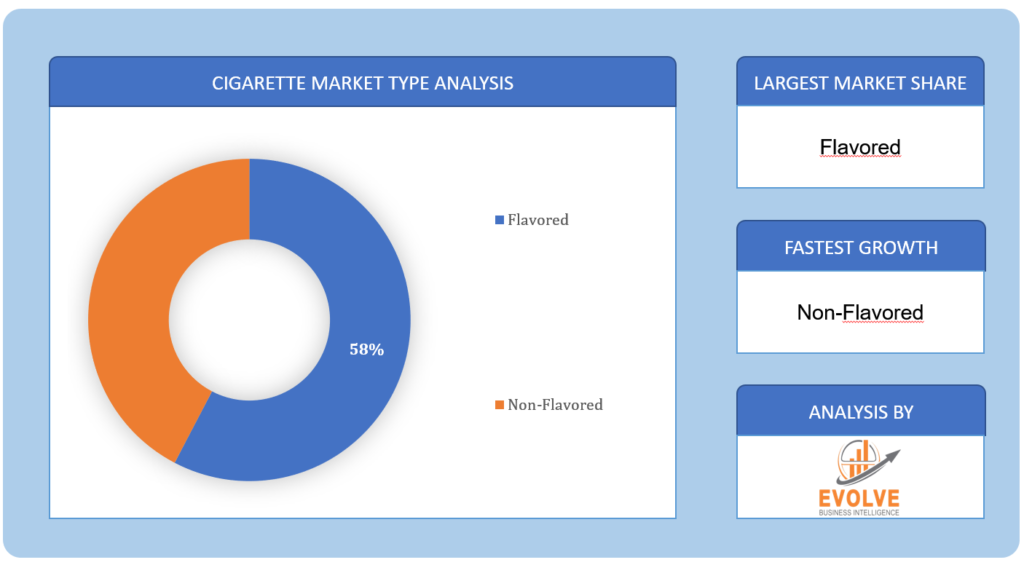The Cigarette Market Size is expected to reach USD 8.74 Billion by 2033. The Cigarette industry size accounted for USD 2.54 Billion in 2023 and is expected to expand at a CAGR of 6.67% from 2023 to 2033. A cigarette is a narrow cylinder of finely cut tobacco leaves that are rolled into thin paper for smoking. The cigarette is ignited at one end, allowing the smoker to inhale the smoke produced by the burning tobacco. Cigarettes are a common form of tobacco consumption and are known for containing the addictive substance nicotine. Smoking cigarettes has well-documented health risks and is a major contributor to various diseases, including respiratory and cardiovascular conditions, as well as an increased risk of certain cancers. Due to health concerns, there have been extensive public health campaigns and regulatory measures aimed at reducing cigarette smoking and promoting tobacco cessation.
Global Cigarette Market Synopsis
The Cigarette market experienced a moderate impact during the COVID-19 pandemic, marked by a complex interplay of challenges and shifts in consumer behavior. Government-imposed lockdowns, restrictions on social activities, and economic uncertainties influenced purchasing patterns, leading to a decline in cigarette consumption in certain regions. However, the stress and anxiety associated with the pandemic prompted some individuals to increase smoking, offsetting the decline to some extent. Disruptions in the supply chain, manufacturing, and distribution also affected the availability of tobacco products. Moreover, heightened health awareness during the pandemic encouraged some smokers to reconsider their habits, contributing to a shift towards smoking cessation. Overall, the pandemic introduced both challenges and opportunities for the cigarette market, highlighting the industry’s vulnerability to external factors and the need for adaptation in response to changing circumstances.
Global Cigarette Market Dynamics
The major factors that have impacted the growth of Cigarette are as follows:
Drivers:
⮚ Addiction to Nicotine
The addictive properties of nicotine stand out as a primary driver in the cigarette market. Nicotine, a highly addictive substance found in tobacco, creates a physiological and psychological dependency among users. This addiction ensures a consistent and reliable demand for cigarettes, as individuals find themselves compelled to continue smoking. The allure of the immediate gratification provided by nicotine contributes to customer loyalty, reinforcing a steady market base for cigarette manufacturers. Despite mounting evidence of the associated health risks, the powerful grip of nicotine addiction remains a formidable force propelling the sustained consumption of cigarettes.
Restraint:
- Stringent Government Regulations
The implementation of stringent government regulations. Governments worldwide are increasingly responding to public health concerns by enacting measures such as anti-smoking campaigns, higher taxes on tobacco products, and stringent bans on public smoking. These regulatory interventions aim to curb the prevalence of smoking, reduce health-related costs, and protect non-smokers from secondhand smoke. As a result, the cigarette market faces challenges in terms of declining sales, shrinking profit margins, and heightened legal scrutiny. Adapting to these regulatory constraints demands strategic innovation and a proactive approach from industry players.
Opportunity:
⮚ Innovation and Alternative Products
The evolving landscape of consumer preferences, coupled with the growing emphasis on health consciousness, presents a notable opportunity for the cigarette market to explore innovative solutions and alternative products. Electronic cigarettes, for instance, have gained traction as a potentially less harmful alternative, providing smokers with a way to satisfy their nicotine cravings without the harmful effects of traditional tobacco combustion. Smoking cessation products, designed to help individuals quit the habit, also represent a promising avenue for industry players. This shift toward healthier alternatives aligns with changing societal attitudes, opening up new avenues for market growth and diversification.
Cigarette Market Segment Overview
By Type
 Based on the Type, the market is segmented based on Flavored and Non-Flavored. The Flavored segment was expected to dominate the Cigarette market, driven by its appeal to a diverse consumer base seeking novel and distinctive smoking experiences. The availability of a wide range of flavors caters to changing preferences and attracts a more expansive market share compared to traditional tobacco products.
Based on the Type, the market is segmented based on Flavored and Non-Flavored. The Flavored segment was expected to dominate the Cigarette market, driven by its appeal to a diverse consumer base seeking novel and distinctive smoking experiences. The availability of a wide range of flavors caters to changing preferences and attracts a more expansive market share compared to traditional tobacco products.
By Format
Based on the Format, the market has been divided into Slim, Super Slim, King Size, and Regular. The Slim segment is poised to lead the Cigarette market, fueled by its popularity among consumers seeking a sleeker and more stylish smoking experience. The demand for slimmer cigarettes reflects a growing trend towards sophistication and a preference for aesthetically appealing tobacco products.
By Distribution Channel
Based on the Distribution Channel, the market has been divided into Offline Retail Stores and Offline Retail Stores. The Offline Retail Stores segment is poised to secure the largest market share in the Cigarette market, driven by the established consumer habit of purchasing tobacco products in traditional brick-and-mortar outlets. The widespread accessibility of offline retail stores and the comfort associated with in-person transactions contribute to the sustained dominance of this distribution channel.
Global Cigarette Market Regional Analysis
Based on region, the market has been divided into North America, Europe, Asia-Pacific, the Middle East & Africa, and Latin America. The area of North America is anticipated to dominate the market for the usage of cigarettes, followed by those in Asia-Pacific and Europe.
 Cigarette North America Market
Cigarette North America Market
North America commands dominance in the Cigarette market, propelled by a combination of factors. The region benefits from a large and consistent consumer base with enduring smoking habits, despite widespread awareness of health risks. Stringent regulations and anti-smoking campaigns have played a role in reducing smoking prevalence, but the market remains robust due to the presence of well-established tobacco companies and the popularity of alternative tobacco products. Additionally, cultural factors and a history of tobacco consumption contribute to the market’s resilience. North America’s economic stability and high disposable income levels also play a role in sustaining cigarette sales, making it a formidable force in the global tobacco industry. The region’s dynamic landscape, characterized by both challenges and opportunities, positions North America as a key player in shaping the future trajectory of the cigarette market.
Cigarette Asia Pacific Market
The Asia-Pacific region has witnessed remarkable growth in the Cigarette market, fueled by a combination of factors. With a vast population and diverse consumer preferences, the region has become a focal point for tobacco industry expansion. Despite increasing awareness of health risks associated with smoking, cultural norms, and long-standing traditions contribute to the sustained demand for cigarettes. The presence of emerging economies with growing middle-class populations further propels market growth, as increased purchasing power leads to higher tobacco consumption. Moreover, the availability of a wide range of cigarette brands, including both international and local varieties, caters to diverse tastes, contributing to the overall expansion of the market in the Asia-Pacific region.
Competitive Landscape
The competitive landscape includes key players (tier 1, tier 2, and local) having a presence across the globe. Companies such as British American Tobacco PLC, Imperial Brands PLC, ITC Limited, Altria Group Inc, and China National Tobacco Corporation are some of the leading players in the global Cigarette Industry. These players have adopted partnership, acquisition, expansion, and new product development, among others as their key strategies.
Key Market Players:
- British American Tobacco PLC
- Imperial Brands PLC
- ITC Limited
- Altria Group Inc
- China National Tobacco Corporation
- Japan Tobacco International SA
- Philip Morris Products SA
- 22nd Century Group
- Korea Tobacco & Ginseng Cooperation
- Eastern Company SAE
Key development:
In October 2022, Altria Group, Inc. disclosed a strategic partnership agreement with JT Group (JT) aimed at jointly marketing and commercializing heated tobacco stick products in the United States, to expand Altria’s heated tobacco product line.
In January 2022, 22nd Century introduced the initial reduced nicotine cigarette, also known as VLN, which received FDA approval to encourage reduced smoking. Currently, the company is actively pursuing an aggressive market entry for VLN.
Scope of the Report
Global Cigarette Market, by Type
- Flavored
- Non-Flavored
Global Cigarette Market, by Format
- Slim
- Super Slim
- King Size
- Regular
Global Cigarette Market, by Distribution Channel
- Offline Retail Stores
- Offline Retail Stores
Global Cigarette Market, by Region
- North America
- US
- Canada
- Mexico
- Europe
- UK
- Germany
- France
- Italy
- Spain
- Benelux
- Nordic
- Rest of Europe
- Asia Pacific
- China
- Japan
- South Korea
- Indonesia
- Austalia
- Malaysia
- India
- Rest of Asia Pacific
- South America
- Brazil
- Argentina
- Rest of South America
- Middle East & Africa
- Saudi Arabia
- UAE
- Egypt
- South Africa
- Rest of Middle East & Africa
| Parameters | Indicators |
|---|---|
| Market Size | 2033: $8.74 Billion |
| CAGR | 6.67% CAGR (2023-2033) |
| Base year | 2022 |
| Forecast Period | 2023-2033 |
| Historical Data | 2021 |
| Report Coverage | Revenue Forecast, Competitive Landscape, Growth Factors, and Trends |
| Key Segmentations | Product Type, Distribution Channel |
| Geographies Covered | North America, Europe, Asia-Pacific, Latin America, Middle East, Africa |
| Key Vendors | British American Tobacco PLC, Imperial Brands PLC, ITC Limited, Altria Group Inc, China National Tobacco Corporation, Japan Tobacco International SA, Philip Morris Products SA, 22nd Century Group, Korea Tobacco & Ginseng Cooperation, Eastern Company SAE |
| Key Market Opportunities | • Shifting consumer preferences offers an opportunity for innovation. • Exploration of alternative products such as electronic cigarettes aligns with health trends. |
| Key Market Drivers | • Persistent demand is driven by the addictive nature of nicotine. • Nicotine dependency creates a consistent market base despite health awareness. |
REPORT CONTENT BRIEF:
- High-level analysis of the current and future Cigarette Industry trends and opportunities
- Detailed analysis of current market drivers, restraining factors, and opportunities analysis in the future
- Historical market size for the year 2021, and forecast from 2023 to 2033
- Cigarette market share analysis for each segment
- Competitor analysis with a comprehensive insight into its product segment, financial strength, and strategies adopted.
- Identifies key strategies adopted by the key players including new product development, mergers and acquisitions, joint ventures, collaborations, and partnerships.
- To identify and understand the various factors involved in the global Cigarette market affected by the pandemic
- To provide year-on-year growth from 2022 to 2033
- To provide short-term, long-term, and overall CAGR comparison from 2022 to 2033.
- Provide Total Addressable Market (TAM) for the Global Cigarette Market.








